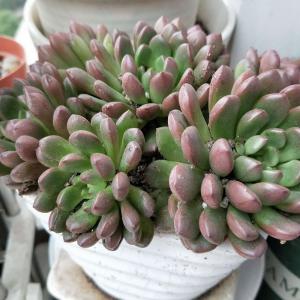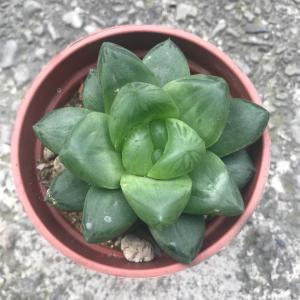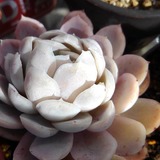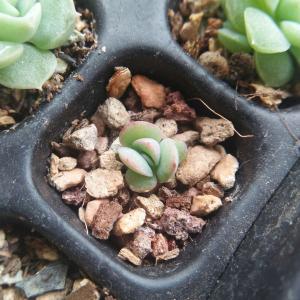文章
Miss Chen
2018年03月19日

Description: This wildflower is an annual or biennial about ½–2' tall. Small plants are unbranched or sparingly branched, while large plants form frequent lateral stems in the upper leaf axils. The stems are light green to reddish purple, 4-angular, and slightly winged; the central stem is erect, while the lateral stems curve upward. Pairs of opposite leaves occur along each stem, each pair rotating about 90° from the pair of leaves immediately below. The leaves are up to 2½" long and about half as much across, becoming slightly smaller as they ascend the stems. The leaves are ovate-cordate to ovate, sessile or slightly clasping at their bases, and smooth along their margins. Their upper surfaces are yellowish green, green, or tinted slightly purple; each leaf has 3-5 parallel veins. Both the stems and leaves are hairless.
The central stem and upper lateral stems (if present) terminate in clusters of 3-7 flowers on short pedicels. Frequently, there are additional clusters of 1-5 flowers from the axils of the upper leaves. All of these flowers are held stiffly erect. Each flower is about ¾" long and ¼" across; it has a long tubular corolla and a short green calyx with 5 slender teeth. The apex of each corolla has 5 triangular lobes that fold together to form a point; the corolla is closed or nearly so. There are no interconnecting fringes to join these lobes. The corollas are blue-violet, purple, or nearly white; they have fine purple veins along their sides. Inside each corolla, there are five stamens and a pistil. The erect lobes of the calyx are narrowly oblong-lanceolate in shape. Underneath the clustered flowers, the leaves are reduced to leafy bracts. The blooming period occur from late summer to mid-fall and lasts about 1-2 months. There is no noticeable floral scent. Each flower is replaced by a seed capsule that dividesDistribution Map into 2 parts to release the numerous tiny seeds. These seeds are distributed by wind and water. The root system consists of a taproot. This wildflower reproduces by reseeding itself; it does not spread vegetatively.
Cultivation: The preference is full sun to light shade, moist to dry conditions, and a somewhat barren soil containing clay or rocky material. Competition from taller plants should be restricted. The size of individual plants and the abundance of their flowers can vary considerably depending on the availability of moisture and nutrients.
Range & Habitat: The native Stiff Gentian is occasional in the northern half of Illinois, while in the southern half of the state it is rare or absent. Populations of this species may be declining. Habitats include hill prairies, upland savannas, thinly wooded slopes, rocky meadows, banks of streams in wooded areas, calcareous seeps, and edges of cliffs. This species is usually found in high quality natural habitats, often where limestone is close to the ground surface.
Faunal Associations: So far, information about floral-faunal relationships for this species has not been encountered. The long tubular shape of the closed corollas suggests that long-tongued bees cross-pollinate the flowers.
Photographic Location: The edge of a partially shaded cliff at the Pine Hills Nature Preserve in west-central Indiana.
Comments: Like several other gentian species, the flowers of Stiff Gentian provide attractive blue-violet color during the fall; this is one of the last species to remain in bloom. Stiff Gentian in Illinois consists of var. occidentalis; the typical variety is found east of Ohio. Stiff Gentian is easily distinguished by its peculiar flowers, which are shorter (1" long or less) and more narrow (¼" across) than the flowers of other gentians with closed corollas. Sometimes, Stiff Gentian is still referred to as Gentiana quinquefolia, but this genus has been reserved for the perennial gentians, of which there are several species still extant in Illinois.
The central stem and upper lateral stems (if present) terminate in clusters of 3-7 flowers on short pedicels. Frequently, there are additional clusters of 1-5 flowers from the axils of the upper leaves. All of these flowers are held stiffly erect. Each flower is about ¾" long and ¼" across; it has a long tubular corolla and a short green calyx with 5 slender teeth. The apex of each corolla has 5 triangular lobes that fold together to form a point; the corolla is closed or nearly so. There are no interconnecting fringes to join these lobes. The corollas are blue-violet, purple, or nearly white; they have fine purple veins along their sides. Inside each corolla, there are five stamens and a pistil. The erect lobes of the calyx are narrowly oblong-lanceolate in shape. Underneath the clustered flowers, the leaves are reduced to leafy bracts. The blooming period occur from late summer to mid-fall and lasts about 1-2 months. There is no noticeable floral scent. Each flower is replaced by a seed capsule that dividesDistribution Map into 2 parts to release the numerous tiny seeds. These seeds are distributed by wind and water. The root system consists of a taproot. This wildflower reproduces by reseeding itself; it does not spread vegetatively.
Cultivation: The preference is full sun to light shade, moist to dry conditions, and a somewhat barren soil containing clay or rocky material. Competition from taller plants should be restricted. The size of individual plants and the abundance of their flowers can vary considerably depending on the availability of moisture and nutrients.
Range & Habitat: The native Stiff Gentian is occasional in the northern half of Illinois, while in the southern half of the state it is rare or absent. Populations of this species may be declining. Habitats include hill prairies, upland savannas, thinly wooded slopes, rocky meadows, banks of streams in wooded areas, calcareous seeps, and edges of cliffs. This species is usually found in high quality natural habitats, often where limestone is close to the ground surface.
Faunal Associations: So far, information about floral-faunal relationships for this species has not been encountered. The long tubular shape of the closed corollas suggests that long-tongued bees cross-pollinate the flowers.
Photographic Location: The edge of a partially shaded cliff at the Pine Hills Nature Preserve in west-central Indiana.
Comments: Like several other gentian species, the flowers of Stiff Gentian provide attractive blue-violet color during the fall; this is one of the last species to remain in bloom. Stiff Gentian in Illinois consists of var. occidentalis; the typical variety is found east of Ohio. Stiff Gentian is easily distinguished by its peculiar flowers, which are shorter (1" long or less) and more narrow (¼" across) than the flowers of other gentians with closed corollas. Sometimes, Stiff Gentian is still referred to as Gentiana quinquefolia, but this genus has been reserved for the perennial gentians, of which there are several species still extant in Illinois.
0
0
文章
Miss Chen
2018年03月19日

Description: This perennial plant is 1-2' tall, with a stout smooth stem that is unbranched. The yellowish or olive green leaves are opposite and strongly clasp the central stem. However, the three leaves beneath the uppermost flowers are whorled. These leaves are broadly lanceolate, ovate, or cordate, and extend up to 3" long and 2" across. There is a prominent central vein, and two side veins that parallel the smooth margins. In the upper half of the plant, 2-7 flowers emerge from the axils of the leaves, with a greater number of flowers at the apex. The tube-shaped flowers are individually about 1½" long and ¾" across, and have 5 petals with small erect tips. They are white, greenish white, or yellowish white, depending on the local ecotype. The blooming period is late summer, and lasts about 1 or 1½ months. There is no noticeable fragrance to the flowers. The seed capsules split into 2 sections, releasing numerous small seeds that can be dispersed by wind or water. The root system consists of a long stout taproot.
Cultivation: The preference is full to partial sun, and moist to average soil conditions. The soil can contain significant amounts of loam, clay, gravel, or sand. Starting plants from seed can be tricky, while transplants are much easier to manage. A yellowish appearance of the leaves is a common reaction to strong sunlight or dry weather, and does not necessarily signify disease or poor health.
Range & Habitat: The native Cream Gentian is a rare plant that occurs in scattered counties in Illinois (see Distribution Map). It can be found in mesic black soil prairies, where it will occasionally form sizeable colonies. Other habitats include the edges of upland forests, sandy oak savannas, limestone glades, and rocky bluffs. Populations of this plant may have occurred in other habitats, such as sand or gravel prairies, but were destroyed before they could be identified.
Faunal Associations: Bumblebees are the primary pollinators of the flowers, where they seek nectar. Some beetles, such as Epicauta pensylvanica (Black Blister Beetle), have been known to knaw on the flowers. White-tailed Deer occasionally chomp off the tops of Cream Gentian plants, but it is not preferred as a food source because of the bitter leaves (personal observation). The relationship of Cream Gentian to other mammalian herbivores is not known at the present time.

Photographic Location: The photographs were taken at Meadowbrook Park in Urbana, Illinois.
Comments: This gentian can be easily distinguished from the others by the absence of blue in the flower. The flowers are not as closed as the Bottle Gentians (e.g., Gentiana andrewsii), but less open than the Prairie Gentian (Gentiana puberulenta). Cream Gentian also blooms about 3 weeks earlier than other gentians. Because it blends into the background of a prairie quite well, this plant can be easy to overlook, even when it is in flower. Like many other gentians, Cream Gentian has an otherworldly beauty that is oddly attractive. Another scientific name for this plant is Gentiana flavida.
Cultivation: The preference is full to partial sun, and moist to average soil conditions. The soil can contain significant amounts of loam, clay, gravel, or sand. Starting plants from seed can be tricky, while transplants are much easier to manage. A yellowish appearance of the leaves is a common reaction to strong sunlight or dry weather, and does not necessarily signify disease or poor health.
Range & Habitat: The native Cream Gentian is a rare plant that occurs in scattered counties in Illinois (see Distribution Map). It can be found in mesic black soil prairies, where it will occasionally form sizeable colonies. Other habitats include the edges of upland forests, sandy oak savannas, limestone glades, and rocky bluffs. Populations of this plant may have occurred in other habitats, such as sand or gravel prairies, but were destroyed before they could be identified.
Faunal Associations: Bumblebees are the primary pollinators of the flowers, where they seek nectar. Some beetles, such as Epicauta pensylvanica (Black Blister Beetle), have been known to knaw on the flowers. White-tailed Deer occasionally chomp off the tops of Cream Gentian plants, but it is not preferred as a food source because of the bitter leaves (personal observation). The relationship of Cream Gentian to other mammalian herbivores is not known at the present time.

Photographic Location: The photographs were taken at Meadowbrook Park in Urbana, Illinois.
Comments: This gentian can be easily distinguished from the others by the absence of blue in the flower. The flowers are not as closed as the Bottle Gentians (e.g., Gentiana andrewsii), but less open than the Prairie Gentian (Gentiana puberulenta). Cream Gentian also blooms about 3 weeks earlier than other gentians. Because it blends into the background of a prairie quite well, this plant can be easy to overlook, even when it is in flower. Like many other gentians, Cream Gentian has an otherworldly beauty that is oddly attractive. Another scientific name for this plant is Gentiana flavida.
0
0
文章
Miss Chen
2018年03月18日

Description: This perennial wildflower consists of a rosette of basal leaves that produces a single flowering stalk about ½–2' tall. The basal leaves are up to 5" long and 3" across; they are oval to obovate in shape, medium green on their upper surfaces, and bluntly dentate toward their tips. The alternate cauline leaves are smaller in size than the basal leaves; they are oblanceolate to oblong and clasp the flowering stalk. Both the basal and cauline leaves are more or less pubescent, particularly on their undersides.
The stout flowering stalk is terete, conspicuously hairy, and unbranched; it terminates in a corymb of several daisy-like flowerheads (typically 1-6 flowerheads, but sometimes more). Each flowerhead is ¾–1¼" across, consisting of 50-100 ray florets that surround numerous yellow disk florets in the center. The ray florets are usually white, less often they are light pink or light violet. The base of each flowerhead has an outer surface consisting of numerous green bracts (phyllaries); these floral bracts are linear in shape and organized into a single series. The blooming period occurs from mid-spring to early summer and lasts about 2-3 weeks. Both the ray and disk florets are fertile, each one producing a single bullet-shaped achene with a tuft of white hairs. These achenes are distributed by the wind. After the blooming period, the flowering stalks die down, but the basal leaves persist. The root system consists of a crown of fibrous roots; rhizomes or stolons are often produced, resulting in small colonies of plants.

Cultivation: The preference is dappled sunlight or partial sun and average to dry conditions. Different kinds of soil are acceptable, including those that contain clay-loam, rocky material, or sand. The best site consists of a partially shaded slope under trees where the ground vegetation is somewhat sparse.
Range & Habitat: The native Robin's Plantain is occasional throughout Illinois in suitable habitats, but it is more common in the northern and west-central sections of the state than elsewhere (see Distribution Map). Habitats include open rocky woodlands, wooded sand dunes, slopes of wooded bluffs, savannas and sandy savannas, banks of streams, and clearings in wooded areas. Robin's Plantain is found in less disturbed areas than other species in this genus.
Faunal Associations: The flowerheads attract small bees, various flies, small butterflies, and skippers. These insects seek nectar primarily, although some of the bees also collect pollen. The caterpillars of several moths feed on the flowers of Erigeron spp. (Fleabanes), including Schinia lynx (Lynx Flower Moth), Schinia obscurata (Obscure Flower Moth), Eupithecia miserulata (Common Pug), and Synchlora aerata (Wavy-Lined Emerald). Some aphids that feed on species in this genus include Aphis middletonii (Erigeron Root Aphid) and Prociphilus erigeronensis. The foliage is palatable to mammalian herbivores (rabbits, deer, livestock, etc.), while the seeds are eaten to a limited extent by the White-Footed Mouse and other small rodents.

Photographic Location: The photograph of the flowerheads was taken at the webmaster's wildflower garden in Urbana, Illinois, while the photograph of the basal leaves was taken on the slope of a wooded bluff in Vermilion County, Illinois.
Comments: The flowerheads of Robin's Plantain are slightly larger than those of other Erigeron spp. (Fleabanes) and rather showy. Other fleabanes in the state are rather weedy annual or biennial species that lack the basal leaves of Robin's Plantain; they usually bloom a little later during the early summer and can be found in sunny habitats with a history of disturbance.
The stout flowering stalk is terete, conspicuously hairy, and unbranched; it terminates in a corymb of several daisy-like flowerheads (typically 1-6 flowerheads, but sometimes more). Each flowerhead is ¾–1¼" across, consisting of 50-100 ray florets that surround numerous yellow disk florets in the center. The ray florets are usually white, less often they are light pink or light violet. The base of each flowerhead has an outer surface consisting of numerous green bracts (phyllaries); these floral bracts are linear in shape and organized into a single series. The blooming period occurs from mid-spring to early summer and lasts about 2-3 weeks. Both the ray and disk florets are fertile, each one producing a single bullet-shaped achene with a tuft of white hairs. These achenes are distributed by the wind. After the blooming period, the flowering stalks die down, but the basal leaves persist. The root system consists of a crown of fibrous roots; rhizomes or stolons are often produced, resulting in small colonies of plants.

Cultivation: The preference is dappled sunlight or partial sun and average to dry conditions. Different kinds of soil are acceptable, including those that contain clay-loam, rocky material, or sand. The best site consists of a partially shaded slope under trees where the ground vegetation is somewhat sparse.
Range & Habitat: The native Robin's Plantain is occasional throughout Illinois in suitable habitats, but it is more common in the northern and west-central sections of the state than elsewhere (see Distribution Map). Habitats include open rocky woodlands, wooded sand dunes, slopes of wooded bluffs, savannas and sandy savannas, banks of streams, and clearings in wooded areas. Robin's Plantain is found in less disturbed areas than other species in this genus.
Faunal Associations: The flowerheads attract small bees, various flies, small butterflies, and skippers. These insects seek nectar primarily, although some of the bees also collect pollen. The caterpillars of several moths feed on the flowers of Erigeron spp. (Fleabanes), including Schinia lynx (Lynx Flower Moth), Schinia obscurata (Obscure Flower Moth), Eupithecia miserulata (Common Pug), and Synchlora aerata (Wavy-Lined Emerald). Some aphids that feed on species in this genus include Aphis middletonii (Erigeron Root Aphid) and Prociphilus erigeronensis. The foliage is palatable to mammalian herbivores (rabbits, deer, livestock, etc.), while the seeds are eaten to a limited extent by the White-Footed Mouse and other small rodents.

Photographic Location: The photograph of the flowerheads was taken at the webmaster's wildflower garden in Urbana, Illinois, while the photograph of the basal leaves was taken on the slope of a wooded bluff in Vermilion County, Illinois.
Comments: The flowerheads of Robin's Plantain are slightly larger than those of other Erigeron spp. (Fleabanes) and rather showy. Other fleabanes in the state are rather weedy annual or biennial species that lack the basal leaves of Robin's Plantain; they usually bloom a little later during the early summer and can be found in sunny habitats with a history of disturbance.
0
0
文章
Miss Chen
2018年03月18日

Description: This perennial plant is about 2½–5' tall, branching occasionally and more or less erect. The stems are variably hairy, sometimes having hairs that occur in lines along their length. These hairs are white and either straight or somewhat curved, but not conspicuously hooked. The compound leaves alternate along the stems; they are trifoliate. The petioles of the compound leaves are about ½–1½" in length. At the base of each petiole is a pair of inconspicuous stipules that are deciduous and at least 5 times longer than they are wide. The leaflets are about 1½–3½" long and about half as much across. They are ovate-lanceolate or ovate and have smooth margins. The base of each leaflet is quite rounded. The upper surface of each leaflet is green or dark green, and nearly glabrous or finely pubescent. The lower surface is light green and faintly reticulate. There are usually fine hairs on the lower leaf surface, especially along the major veins, but the amount is variable.

The upper stems terminate in panicles of light pink to purplish pink flowers. The larger panicles can be 1-2' long and have spreading stems that produce numerous flowers. Each flower is about ¼" long. These flowers have a typical structure for members of the Bean family, consisting of a hood and projecting keel. Near the center of each flower is a patch of white that is surrounded by a thin line of purple. The blooming period can occur from mid-summer to early fall, and lasts about a month. There is no floral scent. Each fertilized flower is replaced by a flat loment (a type of seedpod) consisting of 2-5 rounded segments. These loments are about ¾–1½" long and covered with clinging hairs. The root system consists of a taproot and nodule-forming secondary roots. This plant spreads by reseeding itself.
Cultivation: The preference is partial sun and mesic to slightly dry conditions. This plant usually grows in soil that contains loam, clay-loam, or some kind of rocky material. It does not appear to be affected by powdery mildew to the same extent as Desmodium canadense (Showy Tick Trefoil). Nitrogen is added to the soil through the root nodules.

Range & Habitat: Perplexing Tick Trefoil occurs occasionally in the majority of counties in Illinois; this native plant is a little more common in the southern half of the state than in the northern half (see Distribution Map). The map doesn't distinguish between the distribution of Desmodium perplexum and Desmodium glabellum. Habitats include savannas, rocky upland forests, edges of wooded areas, thickets, and limestone glades.
Faunal Associations: Like other Desmodium spp., long-tongued bees are the primary pollinators of the flowers. Typical visitors include bumblebees, long-horned bees (Melissodes spp.), and leaf-cutting bees (Megachile spp.). These insects collect pollen. The caterpillars of the skippers, Thorybes pylades (Northern Cloudywing) and Thorybes bathyllus (Southern Cloudywing), feed on the foliage. The seeds are eaten by some upland gamebirds and small rodents, including the Bobwhite, Wild Turkey, and White-footed Mouse. Mammalian herbivores eat Tick Trefoils readily, including deer, rabbits, groundhogs, and livestock. These mammals help to distribute the seeds as the loments readily cling to their fur. The loments also cling to the clothing of humans.
Photographic Location: The edge of a wooded area in Judge Webber Park, Urbana, Illinois.
Comments: This Tick Trefoil species can produce large panicles of small flowers that are rather showy. It is one of the Desmodium spp. that blooms later in the year than many others. Unfortunately, it has been re-classified by taxonomists on several occasions, which may be the reason for the 'perplexum' in its scientific name. In some older sources of information, this plant is referred to as Desmodium dillenii and Desmodium glabellum. However, Desmodium glabellum is now considered a separate species with an appearance that is quite similar to Perplexing Tick Trefoil, while Desmodium dillenii is considered a defunct classification. Presumably, Desmodium perplexum and Desmodium glabellum can be distinguished as follows: 1) the former species has a faint reticulated network of veins on the lower surface of the leaflets, while the latter has a strong reticulated network of veins, and 2) the former species has hairs on the stems and leaves that are straight or somewhat curved, while the latter has hooked hairs. Other distinguishing features for Perplexing Tick Trefoil include inconspicuous stipules that are very narrow and deciduous (i.e., they wither away quickly), and petioles of the compound leaves that are at least ½" in length.

The upper stems terminate in panicles of light pink to purplish pink flowers. The larger panicles can be 1-2' long and have spreading stems that produce numerous flowers. Each flower is about ¼" long. These flowers have a typical structure for members of the Bean family, consisting of a hood and projecting keel. Near the center of each flower is a patch of white that is surrounded by a thin line of purple. The blooming period can occur from mid-summer to early fall, and lasts about a month. There is no floral scent. Each fertilized flower is replaced by a flat loment (a type of seedpod) consisting of 2-5 rounded segments. These loments are about ¾–1½" long and covered with clinging hairs. The root system consists of a taproot and nodule-forming secondary roots. This plant spreads by reseeding itself.
Cultivation: The preference is partial sun and mesic to slightly dry conditions. This plant usually grows in soil that contains loam, clay-loam, or some kind of rocky material. It does not appear to be affected by powdery mildew to the same extent as Desmodium canadense (Showy Tick Trefoil). Nitrogen is added to the soil through the root nodules.

Range & Habitat: Perplexing Tick Trefoil occurs occasionally in the majority of counties in Illinois; this native plant is a little more common in the southern half of the state than in the northern half (see Distribution Map). The map doesn't distinguish between the distribution of Desmodium perplexum and Desmodium glabellum. Habitats include savannas, rocky upland forests, edges of wooded areas, thickets, and limestone glades.
Faunal Associations: Like other Desmodium spp., long-tongued bees are the primary pollinators of the flowers. Typical visitors include bumblebees, long-horned bees (Melissodes spp.), and leaf-cutting bees (Megachile spp.). These insects collect pollen. The caterpillars of the skippers, Thorybes pylades (Northern Cloudywing) and Thorybes bathyllus (Southern Cloudywing), feed on the foliage. The seeds are eaten by some upland gamebirds and small rodents, including the Bobwhite, Wild Turkey, and White-footed Mouse. Mammalian herbivores eat Tick Trefoils readily, including deer, rabbits, groundhogs, and livestock. These mammals help to distribute the seeds as the loments readily cling to their fur. The loments also cling to the clothing of humans.
Photographic Location: The edge of a wooded area in Judge Webber Park, Urbana, Illinois.
Comments: This Tick Trefoil species can produce large panicles of small flowers that are rather showy. It is one of the Desmodium spp. that blooms later in the year than many others. Unfortunately, it has been re-classified by taxonomists on several occasions, which may be the reason for the 'perplexum' in its scientific name. In some older sources of information, this plant is referred to as Desmodium dillenii and Desmodium glabellum. However, Desmodium glabellum is now considered a separate species with an appearance that is quite similar to Perplexing Tick Trefoil, while Desmodium dillenii is considered a defunct classification. Presumably, Desmodium perplexum and Desmodium glabellum can be distinguished as follows: 1) the former species has a faint reticulated network of veins on the lower surface of the leaflets, while the latter has a strong reticulated network of veins, and 2) the former species has hairs on the stems and leaves that are straight or somewhat curved, while the latter has hooked hairs. Other distinguishing features for Perplexing Tick Trefoil include inconspicuous stipules that are very narrow and deciduous (i.e., they wither away quickly), and petioles of the compound leaves that are at least ½" in length.
0
0





















